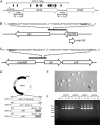Development of a self-replicating plasmid system for Mycoplasma hyopneumoniae
- PMID: 23895236
- PMCID: PMC3765554
- DOI: 10.1186/1297-9716-44-63
Development of a self-replicating plasmid system for Mycoplasma hyopneumoniae
Abstract
Mycoplasma hyopneumoniae is a prevalent swine respiratory pathogen that is a major cause of economic loss to pig producers. Control is achieved by a combination of antimicrobials, vaccination and management practices, but current vaccines offer only partial control and there is a need for improved preventative strategies. A major barrier to advances in understanding the pathogenesis of M. hyopneumoniae and in developing new vaccines is the lack of tools to genetically manipulate the organism. We describe the development and optimisation of the first successful plasmid-based system for the genetic manipulation of M. hyopneumoniae. Our artificial plasmids contain the origin of replication (oriC) of M. hyopneumoniae along with tetM, conferring resistance to tetracycline. With these plasmids, we have successfully transformed M. hyopneumoniae strain 232 by electroporation, generating tetracycline resistant organisms. The persistence of extrachromosomal plasmid and maintenance of plasmid DNA over serial passages shows that these artificial plasmids are capable of self-replication in M. hyopneumoniae. In addition to demonstrating the amenability of M. hyopneumoniae to genetic manipulation and in optimising the conditions necessary for successful transformation, we have used this system to determine the minimum functional oriC of M. hyopneumoniae. In doing so, we have developed a plasmid with a small oriC that is stably maintained over multiple passages that may be useful in generating targeted gene disruptions. In conclusion, we have generated a set of plasmids that will be valuable in studies of M. hyopneumoniae pathogenesis and provide a major step forward in the study of this important swine pathogen.
Figures



References
Publication types
MeSH terms
Substances
Grants and funding
- BB/G018553/1/Biotechnology and Biological Sciences Research Council/United Kingdom
- BB/G019177/1/Biotechnology and Biological Sciences Research Council/United Kingdom
- BB/G019274/1/Biotechnology and Biological Sciences Research Council/United Kingdom
- BB/G020744/1/Biotechnology and Biological Sciences Research Council/United Kingdom
LinkOut - more resources
Full Text Sources
Other Literature Sources

